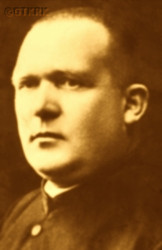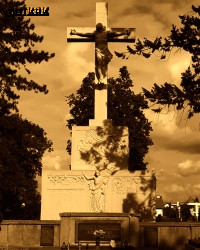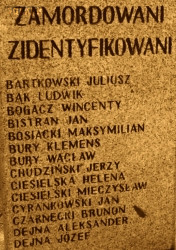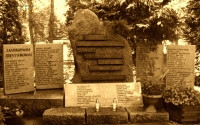Roman Catholic
St Sigismund parish
05-507 Słomczyn
85 Wiślana Str.
Konstancin deanery
Warsaw archdiocese, Poland
full list:
displayClick to display full list

searchClick to search full list by categories
wyświetlKliknij by wyświetlić pełną listę po polsku

szukajKliknij by przeszukać listę wg kategorii po polsku

Martyrology of the clergy — Poland
XX century (1914 – 1989)
personal data
surname
BARTKOWSKI
forename(s)
Julius Stanislav (pl. Juliusz Stanisław)
forename(s)
versions/aliases
Julian
function
diocesan priest
creed
Latin (Roman Catholic) Church RCmore on
en.wikipedia.org
[access: 2014.09.21]
diocese / province
Culm (Chełmno) diocesemore on
pl.wikipedia.org
[access: 2012.11.23]
honorary titles
protonotary apostolic (mitre) „in imitation” (ad instar)more on
en.wikipedia.org
[access: 2014.11.22]
Prelate‐provost (Lat. praelati‐praepositus)more on
en.wikipedia.org
[access: 2015.03.01]
(1932 – , Assumption of the Blessed Virgin Mary RC cathedral church, Pelplintoday: Pelplin gm., Tczew pov., Pomerania voiv., Poland
more on
en.wikipedia.org
[access: 2021.05.06])
Minor Canonmore on
en.wikipedia.org
[access: 2014.11.14]
(23.04.1920 – , Assumption of the Blessed Virgin Mary RC cathedral church, Pelplintoday: Pelplin gm., Tczew pov., Pomerania voiv., Poland
more on
en.wikipedia.org
[access: 2021.05.06])
„Polonia Restituta” Cross — 3rd Class, Commander'smore on
en.wikipedia.org
[access: 2019.04.16]
(10.11.1938)
„Medal of Independence”more on
en.wikipedia.org
[access: 2019.02.02]
(20.12.1932)
date and place
of death
20.10.1939

Tczewtoday: Tczew urban gm., Tczew pov., Pomerania voiv., Poland
more on
en.wikipedia.org
[access: 2021.09.02]
alt. dates and places
of death
21.10.1939
details of death
After German and Russian invasion of Poland in 09.1939 and start of the World War II, after start of German occupation, summoned by the Germans to a meeting on 20.10.1939, at the Pelplin Theological Seminary.
Upon arrival arrested along with 18 Pelplin cathedral canons and professors from the Catholic „Collegium Marianum” gymnasium. On that day, the Germans — members of the genocidal Germ. Volksdeutscher Selbstschutz (Eng. Ethnic German Self–Defense), i.e. VS, treasonous representatives of the German minority in Poland; the Germ. Ordnungspolizei (Eng. Order Police), i.e. OrPo, a formation directly subordinated to the Germ. Chef der Deutschen Polizei (Eng. Chief of the German Police), the genocide master Heinrich Himmler; the paramilitary, genocidal Germ. Die Schutzstaffel der NSDAP (Eng. NSDAP Protection Unit), i.e. «SS», and Germ. Sturmabteilungen der NSDAP (Eng. NSDAP Storm Troops), i.e. «SA», organizations, subordinates to the ruling National Socialist German Workers’ Party NSDAP — arrested, as part of the Germ. «Intelligenzaktion» (Eng. „Intelligence Action”), i.e. the extermination of the Polish intelligentsia and the leadership classes of Pomerania, at least 21 Catholic priests.
Initially, they were herded to Bielawski Forest, c. 5 km to the west. There, they were forced to dig pits.
For some reason — perhaps because the site might have been observed by locals, such as those from the nearby village of Bielawki — they were driven back to Pelplin.
Harassed, insulted, and beaten, were marched through town to the train station.
There, they were loaded onto trucks and driven 20 km north, to the Germ. „Internierungslager” (English: „Internment camp”) IL Dirschau in Tczew, where Poles apprehended on the basis of the so‐called Germ. Sonderfahndungsliste (Eng. Special Wanted List), i.e. a proscription list of names of „enemies of the Reich”, prepared before the German aggression, or on another proscription list, drawn up ad hoc on the basis of denunciations from local Germ. Volksdeutsche (Eng. Ethnic Germans), were held.
In the evening, after torture, the Germans shot 16 of them in the military barracks, in a place traditionally known as the Old Powder House, by shots to the back of the head (Germ. „Genickschuss”).
Some were prob. buried alive in a mass grave.
The crime was committed by a specially brought‐in «SA» commando, under the command of a certain Walter Frösse.
cause of death
mass murder
perpetrators
Germans
sites and events
IL DirschauClick to display the description, «Intelligenzaktion»Click to display the description, Reichsgau Danzig‐WestpreußenClick to display the description, Ribbentrop‐MolotovClick to display the description, Pius XI's encyclicalsClick to display the description
date and place
of birth
13.07.1864Birth certification on:
metryki.genbaza.pl
[access: 2025.09.10]

Gniewtoday: Gniew gm., Tczew pov., Pomerania voiv., Poland
more on
en.wikipedia.org
[access: 2021.07.29]
parents
BARTKOWSKI Marcel
🞲 ?, ? — 🕆 ?, ?

SCHEUMANN Mary
🞲 ?, ? — 🕆 ?, ?
baptism
24.07.1864Birth certification on:
metryki.genbaza.pl
[access: 2025.09.10]

Gniewtoday: Gniew gm., Tczew pov., Pomerania voiv., Poland
more on
en.wikipedia.org
[access: 2021.07.29]
St Nicholas the Bishop and Martyr RC church
presbyter (holy orders)
ordination
27.05.1888

Pelplintoday: Pelplin gm., Tczew pov., Pomerania voiv., Poland
more on
en.wikipedia.org
[access: 2021.05.06]
Assumption of the Blessed Virgin Mary RC cathedral churchmore on
en.wikipedia.org
[access: 2025.03.14]
positions held
1932 – 1939
Prelate‐provost (Lat. praelati‐praepositus) — Pelplintoday: Pelplin gm., Tczew pov., Pomerania voiv., Poland
more on
en.wikipedia.org
[access: 2021.05.06] ⋄ Cathedral Chapter ⋄ Assumption of the Blessed Virgin Mary RC cathedral church
c. 1920 – 1939
curatus — Pelplintoday: Pelplin gm., Tczew pov., Pomerania voiv., Poland
more on
en.wikipedia.org
[access: 2021.05.06] ⋄ Lat. „Depositorium et Aerarium” (Eng. „Deposit and Treasury”), Diocesan Curia
c. 1920 – 1939
official (i.e. bishop's judicial vicar) — Pelplintoday: Pelplin gm., Tczew pov., Pomerania voiv., Poland
more on
en.wikipedia.org
[access: 2021.05.06] ⋄ Bishop's Diocesan Court
c. 1920 – 1939
clerk — Pelplintoday: Pelplin gm., Tczew pov., Pomerania voiv., Poland
more on
en.wikipedia.org
[access: 2021.05.06] ⋄ Consistory (Lat. Consistorium), Diocesan Curia
1920 – 1926
vicar general — Pelplintoday: Pelplin gm., Tczew pov., Pomerania voiv., Poland
more on
en.wikipedia.org
[access: 2021.05.06] ⋄ Pelplin RC diocese
1920 – 1932
Minor Canon — Pelplintoday: Pelplin gm., Tczew pov., Pomerania voiv., Poland
more on
en.wikipedia.org
[access: 2021.05.06] ⋄ Cathedral Chapter ⋄ Assumption of the Blessed Virgin Mary RC cathedral church
1918 – c. 1920
dean — Gniewtoday: Gniew gm., Tczew pov., Pomerania voiv., Poland
more on
en.wikipedia.org
[access: 2021.07.29] RC deanery
30.06.1900 – c. 1920
parish priest — Pelplintoday: Pelplin gm., Tczew pov., Pomerania voiv., Poland
more on
en.wikipedia.org
[access: 2021.05.06] ⋄ Corpus Christi RC parish ⋄ Gniewtoday: Gniew gm., Tczew pov., Pomerania voiv., Poland
more on
en.wikipedia.org
[access: 2021.07.29] RC deanery — also: in c. 1904 secretary of the Cathedral Chapter
from c. 1893
administrator — Pelplintoday: Pelplin gm., Tczew pov., Pomerania voiv., Poland
more on
en.wikipedia.org
[access: 2021.05.06] ⋄ Corpus Christi RC parish ⋄ Gniewtoday: Gniew gm., Tczew pov., Pomerania voiv., Poland
more on
en.wikipedia.org
[access: 2021.07.29] RC deanery
vicar — Pelplintoday: Pelplin gm., Tczew pov., Pomerania voiv., Poland
more on
en.wikipedia.org
[access: 2021.05.06] ⋄ Assumption of the Blessed Virgin Mary RC cathedral church
1889 – 1893
personal chaplain — Pelplintoday: Pelplin gm., Tczew pov., Pomerania voiv., Poland
more on
en.wikipedia.org
[access: 2021.05.06] ⋄ the Bishop — at that time it was Bp Leo Redmer
c. 1888 – c. 1889
vicar — Jeżewotoday: Jeżewo gm., Świecie pov., Kuyavia‐Pomerania voiv., Poland
more on
en.wikipedia.org
[access: 2021.09.02] ⋄ Holy Trinity RC parish ⋄ Świecietoday: Świecie gm., Świecie pov., Kuyavia‐Pomerania voiv., Poland
more on
en.wikipedia.org
[access: 2021.09.02] RC deanery
c. 1888
vicar — Gniewtoday: Gniew gm., Tczew pov., Pomerania voiv., Poland
more on
en.wikipedia.org
[access: 2021.07.29] ⋄ St Nicholas the Bishop and Martyr RC parish ⋄ Gniewtoday: Gniew gm., Tczew pov., Pomerania voiv., Poland
more on
en.wikipedia.org
[access: 2021.07.29] RC deanery
1887 – 1888
student — Pelplintoday: Pelplin gm., Tczew pov., Pomerania voiv., Poland
more on
en.wikipedia.org
[access: 2021.05.06] ⋄ philosophy and theology, Theological Seminary — on 04.10.1887, after the end of the anti–Catholic and anti–Polish German policy, referred to as the Kulturkampf, the Theological Seminary in Pelplin re–opened its doors and started operating
till 1887
student — Munichtoday: Bavaria state, Germany
more on
en.wikipedia.org
[access: 2022.04.12] ⋄ philosophy and theology, Germ. Ludwig–Maximilians–Universität (Eng. Ludwig Maximilian University)
student — Würzburgtoday: Würzburg urban dist., Lower Franconia reg., Bavaria state, Germany
more on
en.wikipedia.org
[access: 2022.08.05] ⋄ philosophy and theology, Department of Theology, Julius–Maximilian University [i.e. Germ. Julius–Maximilians–Universität (Eng. Julius–Maximilian University) (from 1918) / Germ. Königlich Bayerische Julius–Maximilians–Universität (Eng. Royal Bavarian Julius–Maximilian University)]
from 1884
student — Wrocławtoday: Wrocław city pov., Lower Silesia voiv., Poland
more on
en.wikipedia.org
[access: 2021.04.02] ⋄ philosophy and theology, Department of Catholic Theology, University of Wrocław [i.e. University of Wrocław (since 1945) / Frederic Wilhelm University of Silesia (1911‐1945) / Royal University i.e. Breslau Academy (1816‐1911)] — studies outside the diocese, due to the closure of the Theological Seminary in Peplin in the years 1876‐1887, caused by the anti–Catholic and anti–Polish German policy, which went down in history as the Kulturkampf
1881 – 1884
pupil — Chełmnotoday: Chełmno urban gm., Chełmno pov., Kuyavia‐Pomerania voiv., Poland
more on
en.wikipedia.org
[access: 2021.07.25] ⋄ Germ. Königliche Katholische Gymnasium (Eng. Royal Catholic Gymnasium)
1872 – 1881
pupil — Pelplintoday: Pelplin gm., Tczew pov., Pomerania voiv., Poland
more on
en.wikipedia.org
[access: 2021.05.06] ⋄ „Collegium Marianum” progymnasium
1905 – 1937
membership — Toruńtoday: Toruń city pov., Kuyavia‐Pomerania voiv., Poland
more on
en.wikipedia.org
[access: 2021.06.20] ⋄ scientific society
others related
in death
BISTRAMClick to display biography John, DZIARNOWSKIClick to display biography Augustine Charles, GRAJEWSKIClick to display biography Joseph, JANKOWSKIClick to display biography John, KIRSTEINClick to display biography Paul, KUROWSKIClick to display biography Paul, LEWANDOWSKIClick to display biography Louis, PARTYKAClick to display biography Boleslav, RASZEJAClick to display biography Maximilian Joseph, ROSKWITALSKIClick to display biography Joseph, RÓŻYŃSKIClick to display biography Francis Louis, SCHÜTTClick to display biography Walter, SIELSKIClick to display biography Julius Vaclav, WIŚNIEWSKIClick to display biography John, ZAREMBAClick to display biography John Francis
sites and events
descriptions
IL Dirschau: Germ. „Internierungslager” (Eng. „Internment camp”) established set up by the Germans on 10.09.1939 in Tczew for arrested inhabitants of Tczew county — on the basis of proscription lists prepared before the German attack on Poland and the start of World War II, by German officials of the Germ. Reichssicherheitshauptamt (Eng. Reich Main Security Office), i.e. RSHA, or on the basis of denunciations from German neighbors — operating on the premises of former Polish military barracks, and from the end of 11.1939 in the building of a crafts school. The camp staff consisted mainly of local Germans, i.e. representatives of the German minority in Poland, members of the genocidal Germ. Volksdeutscher Selbstschutz (Eng. Ethnic German Self–Defense), i.e. VS, the creation of which on Polish lands occupied by German troops was decided in Berlin on 08‐10.09.1939 at a conference headed by Reichsführer‐SS Heinrich Himmler (call order of 20.09.1939), directly subordinated to the genocidal Germ. Schutzstaffel der NSDAP (Eng. NSDAP protection unit), i.e. the «SS», „protecting” the National Socialist German Workers' Party NSDAP; but also members of the «SS» and another genocidal German paramilitary militia organization, Germ. Sturmabteilungen der NSDAP (Eng. NSDAP Storm Troops), i.e. the «SA». The camp commandant was a certain SS‐Scharführer Ervin Martens. He also headed a special „commission” that conducted daily prisoner selections and run a kind of „kangaroo court martial”, issuing execution „sentences” without evidentiary proceedings. The murders were carried out by an execution squad consisting of members of the camp's crew and a special «SA» commando from Gdańsk, under the command of a certain Walter Fröse. Altogether c. 1,000‐1,500 people where incarcerated and repeatedly tortured. 120‐150 were murdered in the barracks including 16 priests from Pelplin. Some were mass murdered in Szpęgawsk forest, others were transferred to KL Stutthof concentration camp. (more on: pl.wikipedia.orgClick to attempt to display webpage
[access: 2015.09.30], zbrodniapomorska1939.plClick to attempt to display webpage
[access: 2023.12.09])
«Intelligenzaktion»: German: «Intelligenzaktion» (English: „Intelligence Action”) — a German program of extermination of the Polish elite, mainly the intelligentsia and leadership layers, carried out from the beginning of the occupation in w 09.1939 to 04.1940, mainly in territories directly annexed to Germany, but also in the so‐called Germ. Generalgouvernement (Eng. General Governorate), where it was called «AB‐aktion». In the first phase, immediately after the beginning of the German occupation, during military operations carried out by the Germ. Wehrmacht (Eng. Armed Forces) and the genocidal units of the Germ. Einsatzgruppen (Eng. Operational Groups) of the Germ. Sicherheitspolizei (Eng. Security Police), i.e. SiPo, and Germ. Sicherheitsdienst des Reichsführers SS (Eng. Security Service of the Reichsführer SS), i.e. SD, organized by the Germ. Reichssicherheitshauptamt (Eng. Reich Main Security Office), i.e. RSHA, which followed the troops, carried out under the Germ. Unternehmen „Tannenberg” (Eng. Operation „Tannenberg”) — based on the so‐called Germ. Sonderfahndungsliste (Eng. Special Wanted Lists), i.e. proscription lists of Poles considered particularly dangerous to the Third Reich, prepared by the Zentralstelle II/P (Polen) unit of the German RSHA. Later, implemented by the German civilian occupation authorities and the genocidal unit of the Germ. Volksdeutscher Selbstschutz (Eng. Ethnic Germans Self‐Defense), whose members were Germ. Volksdeutsche (Eng. Ethnic Germans), i.e. representatives of the German minority in Poland. According to various sources, these lists, at the beginning of 09.1939, could have contained the details of 61,000—88,000 „dangerous” Poles — although these figures cannot be confirmed. In total, during this genocide, c. 50,000 teachers, Catholic priests, representatives of the landed gentry, freelancers, social and political activists, and retired military personnel were systematically and methodically murdered. Another 50,000 were sent to concentration camps, where only a negligible percentage survived. (more on: en.wikipedia.orgClick to attempt to display webpage
[access: 2014.10.04])
Reichsgau Danzig‐Westpreußen: After the Polish defeat in the 09.1939 campaign, which was the result of the Ribbentrop‐Molotov Pact and constituted the first stage of World War II, and the beginning of German occupation in part of Poland (in the other, eastern part of Poland, the Russian occupation began), the Germans divided the occupied Polish territory into five main regions (and a few smaller). The largest one was transformed into Germ. Generalgouvernement (Eng. General Governorate), intended exclusively for Poles and Jews and constituting part of the so‐called Germ. Großdeutschland (Eng. Greater Germany). Two were added to existing German provinces. From two other separate new provinces were created. Vistula Pomerania region was one of them, incorporated into Germany on 08.10.1939, by decree of the German leader Adolf Hitler (formally came into force on 26.10.1939), and on 02.11.1939 transformed into the Germ. Reichsgau Danzig‐Westpreußen (Eng. Reich District of Gdańsk‐West Prussia) province, in which the law of the German state was to apply. The main axis of the policy of the new province, the territory of which the Germans recognized as the Germ. „Ursprünglich Deutsche” (Eng. „natively German”), despite the fact that 85% of its inhabitants were Poles, was Germ. „Entpolonisierung” (Eng. „Depolonisation”), i.e. forced Germanization. C. 60,000 Poles were murdered in 1939‐1940, as part of the Germ. „Intelligenzaktion”, i.e. extermination of Polish intelligentsia and ruling classes, in c. 432 places of mass executions — including c. 220 Polish Catholic priests. The same number were sent to German concentration camps, from where few returned (over 300 priests were arrested, of whom c. 130 died in concentration camps). C. 124,000‐170,000 were displaced, including c. 90,000 to the Germ. Generalgouvernement. Poles were forced en masse to sign the German nationality list, the Germ. Deutsche Volksliste DVL. Polish children could only learn in German. It was forbidden to use the Polish language during Catholic Holy Masses and during confession. Polish landed estates were confiscated..To further reduce the number of the Polish population, Poles were sent to forced labor deep inside Germany. The remaining Poles were treated as low‐skilled labor, isolated from the Germans and strictly controlled — legally, three or three of them could only meet together, even in their own apartments. Many were conscripted into the German Wehrmacht army. After the end of hostilities of World War II, the overseer of this province, the Germ. Reichsstatthalter (Eng. Reich Governor) and the Germ. Gauleiter (Eng. district head) of the German National Socialist Party, Albert Maria Forster, was executed. (more on: en.wikipedia.orgClick to attempt to display webpage
[access: 2024.06.24])
Ribbentrop‐Molotov: Genocidal Russian‐German alliance pact between Russian leader Joseph Stalin and German leader Adolf Hitler signed on 23.08.1939 in Moscow by respective foreign ministers, Mr. Vyacheslav Molotov for Russia and Joachim von Ribbentrop for Germany. The pact sanctioned and was the direct cause of joint Russian and German invasion of Poland and the outbreak of the World War II in 09.1939. In a political sense, the pact was an attempt to restore the status quo ante before 1914, with one exception, namely the „commercial” exchange of the so‐called „Kingdom of Poland”, which in 1914 was part of the Russian Empire, fore Eastern Galicia (today's western Ukraine), in 1914 belonging to the Austro‐Hungarian Empire. Galicia, including Lviv, was to be taken over by the Russians, the „Kingdom of Poland” — under the name of the General Governorate — Germany. The resultant „war was one of the greatest calamities and dramas of humanity in history, for two atheistic and anti‐Christian ideologies — national and international socialism — rejected God and His fifth Decalogue commandment: Thou shall not kill!” (Abp Stanislav Gądecki, 01.09.2019). The decisions taken — backed up by the betrayal of the formal allies of Poland, France and Germany, which on 12.09.1939, at a joint conference in Abbeville, decided not to provide aid to attacked Poland and not to take military action against Germany (a clear breach of treaty obligations with Poland) — were on 28.09.1939 slightly altered and made more precise when a treaty on „German‐Russian boundaries and friendship” was agreed by the same murderous signatories. One of its findings was establishment of spheres of influence in Central and Eastern Europe and in consequence IV partition of Poland. In one of its secret annexes agreed, that: „the Signatories will not tolerate on its respective territories any Polish propaganda that affects the territory of the other Side. On their respective territories they will suppress all such propaganda and inform each other of the measures taken to accomplish it”. The agreements resulted in a series of meeting between two genocidal organization representing both sides — German Gestapo and Russian NKVD when coordination of efforts to exterminate Polish intelligentsia and Polish leading classes (in Germany called «Intelligenzaktion», in Russia took the form of Katyń massacres) where discussed. Resulted in deaths of hundreds of thousands of Polish intelligentsia, including thousands of priests presented here, and tens of millions of ordinary people,. The results of this Russian‐German pact lasted till 1989 and are still in evidence even today. (more on: en.wikipedia.orgClick to attempt to display webpage
[access: 2015.09.30])
Pius XI's encyclicals: Facing the creation of two totalitarian systems in Europe, which seemed to compete with each other, though there were more similarities than contradictions between them, Pope Pius XI issued in 03.1937 (within 5 days) two encyclicals. In the „Mit brennender Sorge” (Eng. „With Burning Concern”) published on 14.03.1938, condemned the national socialism prevailing in Germany. The Pope wrote: „Whoever, following the old Germanic‐pre‐Christian beliefs, puts various impersonal fate in the place of a personal God, denies the wisdom of God and Providence […], whoever exalts earthly values: race or nation, or state, or state system, representatives of state power or other fundamental values of human society, […] and makes them the highest standard of all values, including religious ones, and idolizes them, this one […] is far from true faith in God and from a worldview corresponding to such faith”. On 19.03.1937, published „Divini Redemptoris” (Eng. „Divine Redeemer”), in which criticized Russian communism, dialectical materialism and the class struggle theory. The Pope wrote: „Communism deprives man of freedom, and therefore the spiritual basis of all life norms. It deprives the human person of all his dignity and any moral support with which he could resist the onslaught of blind passions […] This is the new gospel that Bolshevik and godless communism preaches as a message of salvation and redemption of humanity”… Pius XI demanded that the established human law be subjected to the natural law of God , recommended the implementation of the ideal of a Christian state and society, and called on Catholics to resist. Two years later, National Socialist Germany and Communist Russia came together and started World War II. (more on: www.vatican.vaClick to attempt to display webpage
[access: 2023.05.28], www.vatican.vaClick to attempt to display webpage
[access: 2023.05.28])
sources
personal:
www.zkp.tczew.plClick to attempt to display webpage
[access: 2012.11.23], www.niedziela.diecezja.torun.plClick to attempt to display webpage
[access: 2013.05.19], katecheza.diecezja-pelplin.plClick to attempt to display webpage
[access: 2023.07.16], metryki.genbaza.plClick to attempt to display webpage
[access: 2025.09.10], informator.pelplin.plClick to attempt to display webpage
[access: 2013.08.31], pbc.gda.plClick to attempt to display webpage
[access: 2023.07.16]
bibliographical:
„Biographical dictionary of priests of the Chełmno diocese ordained in the years 1821‐1920”, Henry Mross, Pelplin, 1995
original images:
informator.pelplin.plClick to attempt to display webpage
[access: 2013.08.31], www.panoramio.comClick to attempt to display webpage
[access: 2015.04.18], www.portalpomorza.plClick to attempt to display webpage
[access: 2015.04.18]
LETTER to CUSTODIAN/ADMINISTRATOR
If you have an Email client on your communicator/computer — such as Mozilla Thunderbird, Windows Mail or Microsoft Outlook, described at WikipediaPatrz:
en.wikipedia.org, among others — try the link below, please:
LETTER to CUSTODIAN/ADMINISTRATORClick and try to call your own Email client
If however you do not run such a client or the above link is not active please send an email to the Custodian/Administrator using your account — in your customary email/correspondence engine — at the following address:

giving the following as the subject:
MARTYROLOGY: BARTKOWSKI Julius Stanislav
To return to the biography press below:
 Click to return to biography
Click to return to biography












